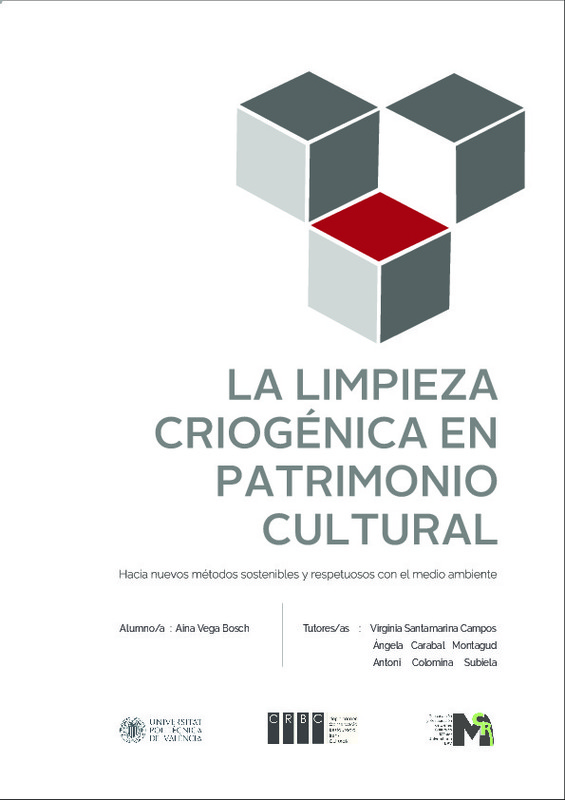|
Resumen:
|
[ES] En el presente trabajo de investigación se recoge un análisis sobre las tendencias en investigación y aplicación de la limpieza criogénica como tratamiento eficiente y sostenible en el sector tecnológico, alimentario ...[+]
[ES] En el presente trabajo de investigación se recoge un análisis sobre las tendencias en investigación y aplicación de la limpieza criogénica como tratamiento eficiente y sostenible en el sector tecnológico, alimentario e industrial, para su posible incorporación en el campo de la conservación del patrimonio cultural. Esta técnica de limpieza se caracteriza por ser inocua para el operador y no requerir lavados posteriores o tiempos de evaporación a causa de la retención de los disolventes. La introducción de la limpieza criogénica a los requerimientos de la profesión resulta un recurso innovador, lleno de beneficios para el ámbito de la conservación y restauración, además de contribuir con los Objetivos y Metas de Desarrollo Sostenible que presentó la Organización de las Naciones Unidas para el próximo 2030.
La búsqueda de nuevos sistemas de limpieza inocuos para la obra y el operador que la interviene, se ha convertido en una vía de investigación prioritaria y de suma importancia para el sector patrimonial. La inclusión de sistemas de limpieza gelificados, mixtos y acuosos, incorporó nuevos parámetros de medición que permitían elaborar protocolos de limpieza más efectivos y menos nocivos. No obstante, el desarrollo de Solvent Gel y sistemas emulsionados, impulsó consigo la investigación de soluciones alternativas que, a su vez, remediasen la problemática asociada al residuo no volátil depositado en las superficies, fruto del uso de tensoactivos y compuestos gelificantes.
De este modo, herramientas, productos y tratamientos diseñados para otros sectores, han sido habitualmente reaprovechados por los restauradores, con el fin de reducir las limitaciones técnicas de nuestras intervenciones e introducir alternativas ante las necesidades que puedan identificarse en el bien patrimonial y los operadores que aseguran su perdurabilidad.
Toda contribución dirigida a conseguir dicho objetivo, permitirá avanzar en la senda hacia una restauración más segura, ecológica y sostenible, reduciendo la peligrosidad que llevan consigo algunas intervenciones que atentan contra nuestra salud y la perdurabilidad de los materiales patrimoniales sobre las que se acomete.
[-]
[EN] This research work includes an analysis of the trends in research and application of dry ice blasting as an efficient and sustainable treatment in the technological, food and industrial sector with a view to its ...[+]
[EN] This research work includes an analysis of the trends in research and application of dry ice blasting as an efficient and sustainable treatment in the technological, food and industrial sector with a view to its possible incorporation in the field of cultural heritage conservation.
The introduction of dry ice blasting to the requirements of the profession is an innovative resource, full of benefits for the field of conservation and restoration, in addition to contributing to the Sustainable Development Goals presented by the United Nations Organization for the next 2030.
The discovery of new cleaning systems that are harmless for the work and the operator, has become a priority research path and hugely important for the heritage sector. The inclusion of gelled, mixed and aqueous cleaning systems incorporated new measurement parameters that allowed the development of more effective and less harmful cleaning protocols. However, the development of Solvent Gel and emulsified systems led to the research of alternative solutions that remedied the problems associated with the non-volatile residue, which is deposited on surfaces after the use of surfactants and gelling compounds.
In this way, tools, products and treatments designed for other sectors have usually been reused by restorers in order to reduce the technical limitations of our interventions. The aim is to introduce alternatives to the needs that can be identified in the heritage property and the operators that ensure its durability.
Any contribution aimed at achieving this objective will allow us to advance on the path towards a safer, more ecological and sustainable restoration, reducing the danger associated with some interventions that threaten our health and the durability of the heritage materials.
[-]
|







